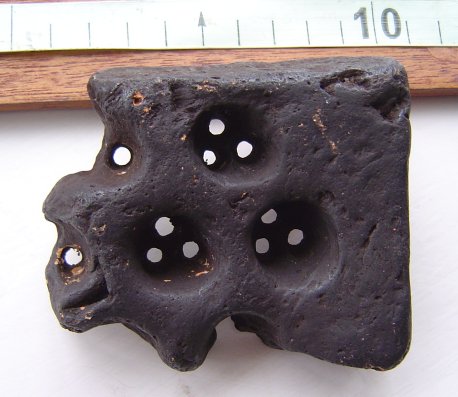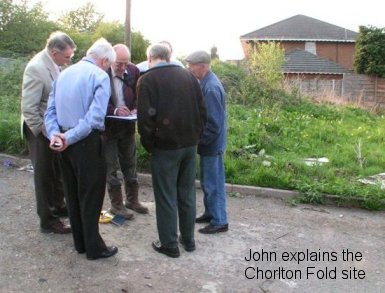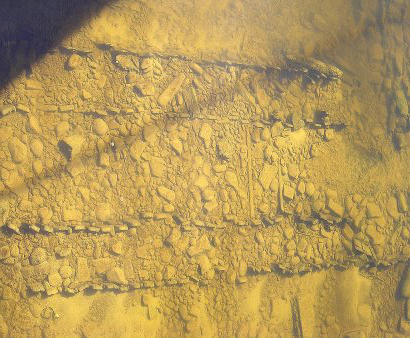 Last
month this single piece of perforated kiln tile turned up on the site of
the Doughty Mill in the Arley Valley. It is almost ten years ago since we
excavated the site on the banks of the River Douglas in search of a
Medieval corn mill (a mill is documented in this area as early as the 13th
century). Our excavations did turn up a building straddling a mill race
(see our Arley Mills report
published under Projects) but,
at the time, there was no evidence to confirm that it was the corn mill we
were looking for. This tile fragment is the first real piece of evidence
for a corn mill at this location. Last
month this single piece of perforated kiln tile turned up on the site of
the Doughty Mill in the Arley Valley. It is almost ten years ago since we
excavated the site on the banks of the River Douglas in search of a
Medieval corn mill (a mill is documented in this area as early as the 13th
century). Our excavations did turn up a building straddling a mill race
(see our Arley Mills report
published under Projects) but,
at the time, there was no evidence to confirm that it was the corn mill we
were looking for. This tile fragment is the first real piece of evidence
for a corn mill at this location. A few hundred metres down
stream, fed by the same mill race, is the Blacking Mill. Both this mill
and the Doughty mill are indicated on an early estate map, but it is quite
evident, judging by the size and type of the grinding wheels, that the
Blacking Mill was never meant for grinding corn.
This newly discovered tile is very similar to the ones we found at the
Standish Hall Corn Mill
(again report published under
Projects) and probably dates to the 17th or 18th century. Tiles of
this age are hand-made and quite rare. They were used extensively in kilns
for the floors where the corn was spread out to dry, which suggests a
building of similar proportions to the one we found at Standish. However,
given the present conditions of the site, it would be very difficult to
find one in this area and we have no plans as yet to investigate it
further.
Excavation Potential
I reported earlier in the year that John Rabbit had been investigating
at Chorlton Fold, a site to the west of the Three Sisters site, where we
helped him to excavate last year (see Newsletters 83
and 85). John is looking for a continuation of
the Roman road from Manchester to Wigan. Small evaluation trenches,
carried out in the area earlier this summer, were very positive and even
suggest some Medieval activity. The land owner (Mark Hammond of Leaway
Manchester) is happy to let John excavate but, as Mark wants to develop
the area, the site is subject to planning regulations (PPG16). Over the
summer, John and Mark have been in negotiations with Norman Redhead from
the GMAU, to find a way forward. These negotiations have now been resolved
and a collaborative arrangement has been agreed between the residence
association and GMAU. This will give local enthusiasts and amateur
societies a unique chance to work along side the professionals. In the
present climate of developer funding, where volunteer involvement is
rarely accepted, this is
 quite a step forward and it will be interesting
to see how it pans out. Works starts on the 9th October and the site will
be open to volunteers from the 11th October. We have been invited to take
part, so if you are interested please contact me asap. quite a step forward and it will be interesting
to see how it pans out. Works starts on the 9th October and the site will
be open to volunteers from the 11th October. We have been invited to take
part, so if you are interested please contact me asap.
Next WAS Meeting
Wednesday 4h October at the District Scout HQ (Baden Powell Centre) in
Greenough Street, starting at 7.30 pm as usual. This month's speaker is
Peter Iles, the County Archaeologist for Lancashire. His talk is on
The Motte and Bailey Castles in the Lune Valley.
This summer Peter made a remarkable discovery in the riverbed of the
Lune as it passes through Lancaster. Because of the unusually dry weather,
the river has been running quite low, which gave Peter the unique
opportunity to take this remarkable picture. Although lying 2 feet under
water, detail can clearly be seen of what is probably the original Roman
ford at Lancaster.
Two pairs of vertical wooden posts run parallel to each
other across the river, retaining the large stones that form the base of
the ford.
The arrangement is such that the structure is well protected from the
constant scouring of the river. It seems to lie below the remains of the
Medieval bridge and, if its age can be proven, will be quite a unique
structure in the Roman world. 
More details can be found on the Lancashire C.C.'s
website;
www.lancashire.gov.uk/environment/historichighways/roman.asp
but I'm sure Peter will be able to tell us more at the meeting.
Hope to see you there. B.A.
|



